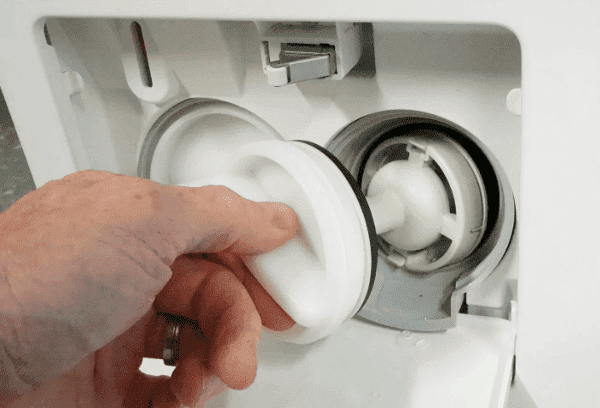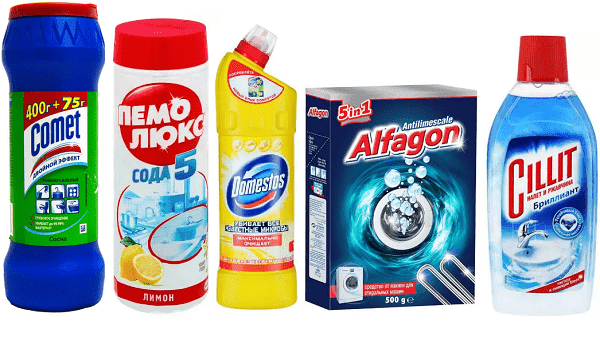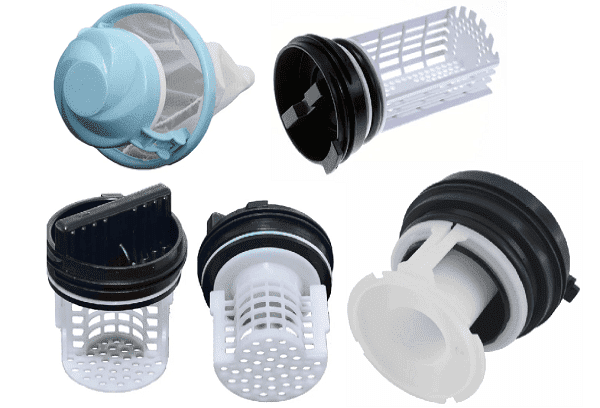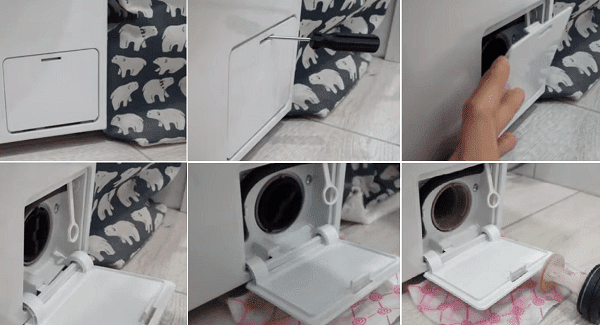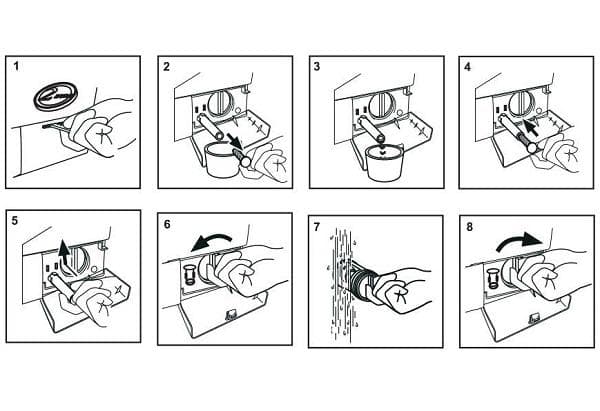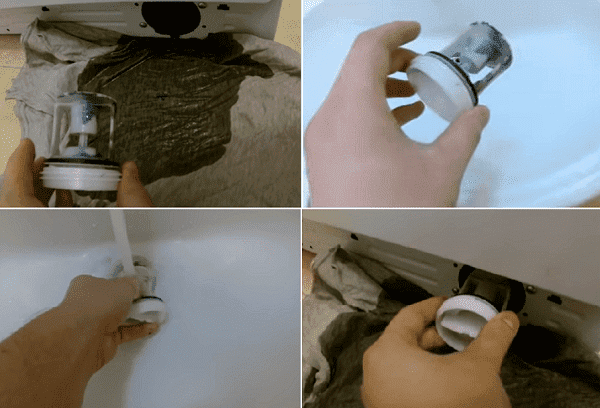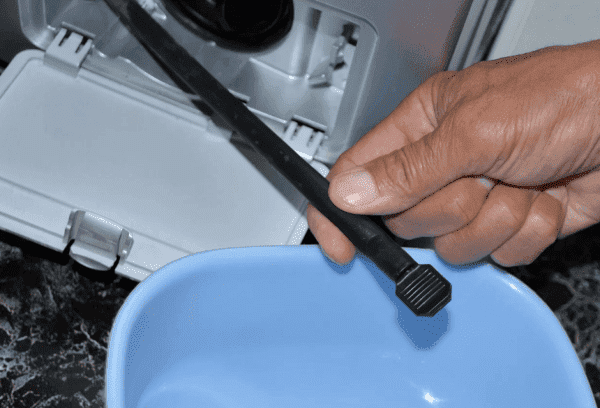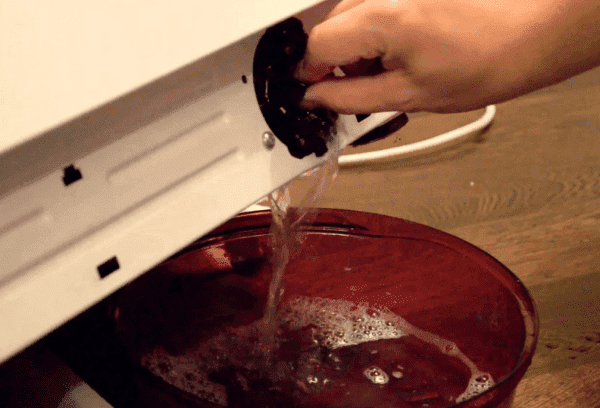Cleaning the washing machine filter - simple and necessary tips
Content:
- Reasons for clogged filters
- What happens if the filter is not cleaned?
- Store-bought cleaning products
- Folk recipes
- Types of filters and signs of their clogging
- How to remove a filter from a washing machine: step-by-step instructions
- Problems when removing the filter
- How to properly clean the filter
- What to do if the filter leaks after cleaning
- How often should you clean the drain filter in your washing machine?
Not everyone knows how to clean the filter in a washing machine, but it’s quite easy to do. First you need to find its location. By the way, both the drain and the fill trap can become clogged. Our service staff recommends checking the condition of the filters from time to time and removing dirt from them if necessary. After cleaning, the part must be correctly installed in its original place.
Reasons for clogged filters
The problem of clogged household appliances can arise as a result of large objects, such as coins or buttons, getting into the tank. For this reason, you need to inspect your clothes before putting them in the wash. Pockets must be empty. Bras and socks should be placed in a special mesh bag before washing to avoid mechanical clogging.Items decorated with sequins, rhinestones or beads are washed inside out.
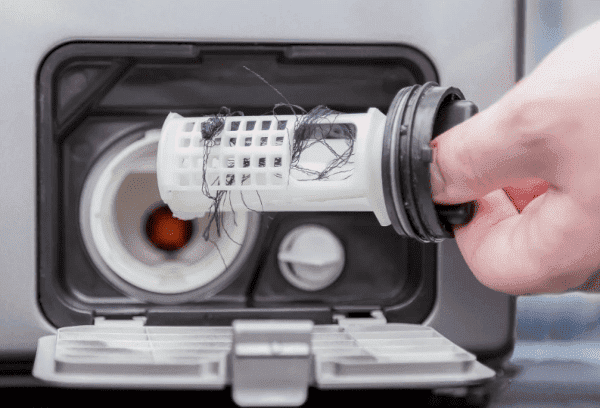
Clogging can occur gradually when the following enters the tank during washing:
- sand;
- lint;
- thread;
- hair;
- animal hair.
As small contaminants accumulate, they can completely clog the drain system. This kind of blockage is called natural. Therefore, filter cleaning must be carried out periodically even if the equipment is handled carefully.
The filter unit will become clogged more often if you use low-quality washing powder or leave washed clothes in the drum for a long time. Constant excess moisture inside the machine will quickly lead to the appearance of mold on internal surfaces and parts.
What happens if the filter is not cleaned?
Symptoms of a blockage can manifest in different ways. If there is a partial blockage, water will linger in the tank and drain more slowly than before. In this case, the unit can display a digital code on the display indicating an error. If the situation is neglected or in the event of a mechanical blockage, the washing cycle freezes, since debris blocks the pump and it stops pumping water.
The machine stops working. Undrained liquid is visible in the tank. Such signs may also appear during more serious breakdowns, for example, if the drain pump has failed. To rule out this option, you need to remove the filter and inspect it.
If the trap is partially leaking water, more and more dirt will accumulate inside. The deposits will serve as a favorable environment for microbes, and the dirt will begin to sour. There will be a repulsive smell coming from the machine. Washed clothes won't smell fresh either.
A foreign body that accidentally gets into the inside of the unit can slip into the drain during repeated washings and cause its breakdown. In this case, car owners will face expensive repairs or a complete replacement of the unit.
Store-bought cleaning products
Professional cleaning products for washing machines basically get rid of scale. The drain filter is cleaned after removal from the unit, using well-known industrial compounds belonging to the category of household chemicals. For cleaning you can use:
- "Pemolux" – in its action the product is similar to soda and is used in the form of a solution for soaking;
- "Alfagon" – the composition removes plaque and scale well on the filter element;
- "Comet" – not only removes dirt, but also fights fungus and rust;
- "Domestos" – a strong remedy that is susceptible to all types of pollution;
- "Silit" – the composition includes surfactants and oxalic acid, which ensures effective removal of persistent stains.
After the initial cleaning of dirt, apply cleaning powder or gel to the filter and rinse it well with an old toothbrush or foam sponge. If there are traces of rust or limescale on the filter element, soak it in the Silita solution for 1-2 hours. This time will be enough for the layers to completely dissolve.
Folk recipes
Folk remedies also effectively deal with contaminants on the filter. They are used to prepare a solution in which the mesh and valve of the filter element are soaked:
- Baking soda will effectively clean the filter of mucus, stubborn dirt and rust. The solution is prepared from 2 tbsp. spoons of product and 1 liter of water. The valve and mesh are soaked in the composition for 15-20 minutes.Then the parts will need to be rinsed with running water.
- Vinegar will remove limescale, unpleasant odors, and stubborn stains. To prepare the solution you will need 1 liter of water and a glass of 9% vinegar. Soaking time – 6-8 hours.
- Citric acid cleans not only the filter, but also the heating element, as well as the loading compartment for the powder. You need to pour one sachet of product into the machine and start a wash cycle at 60° C. After this, all the internal elements of the machine will become spotlessly clean.
If there is a moldy smell coming from the machine, you can use “Whiteness” to clean the filter. The product will not only dissolve dirt, but also provide disinfection. The mixture is half diluted with water and the filter is soaked in it for 1 hour.
Types of filters and signs of their clogging
Modern washing machines are equipped with filter elements at the inlet and outlet. The inlet catcher filters the water supplied for washing, freeing it from suspended matter and metal particles that enter the watercourse from the pipes.
Foreign inclusions can be either large or smaller, almost invisible to the eye. Over time, the mesh becomes clogged and the washing machine takes longer to fill with water. Freeing the filter from dirt solves the problem.
There are many more signs of a dirty drain catcher. In particular, you may notice the following symptoms:
- the machine displays an error code;
- the rate of liquid pumping decreases;
- a complete blockage of the unit may occur;
- During the wash cycle, the machine does not switch to the “rinse” mode;
- the electronics are turned off in the “spin” mode;
- the tank will remain filled with water.
In all of the above cases, cleaning is inevitable. To avoid such problems, it is better to clean the filter preventatively.
How to remove a filter from a washing machine: step-by-step instructions
If we are talking about a filler filter, you need to look for it on the back of the machine in the valve that regulates the flow of water. You must first disconnect the unit from the power supply and shut off the water supply from the water supply. After this, unscrew the hose and, using tweezers or pliers, carefully unscrew the mesh from the inlet valve.
As for the drainage device, the design may vary depending on the brand of washing unit:
- to clean the filter in the Indesit washing machine, you should look for the catcher at the bottom right, it is covered with a removable panel;
- You can also remove the filter from the Bosch washing machine by slightly opening the decorative panel at the bottom right;
- to remove the filter from the LG washing machine, they act in a different way; the filter element here is installed on the left at the bottom of the front panel;
- You can clean the filter in a Samsung washing machine yourself by removing it through the hatch located in the lower right corner of the unit;
- to remove the filter element from the Ariston unit, you need to remove the removable hatch cover located in the lower part of the front panel on the right;
- on Kandy units, the manufacturer installed a filter system on the left and equipped it with a hatch;
- in the Electrolux machine with vertical loading and other similar models, the catcher is built into the edge of the drum; it can only be reached from the inside.
Place a plate or other suitable container to collect water under the location of the filter. A rag will also not be superfluous. Then you need to gain access to the filter by moving the decorative panel or pulling the hatch towards you. The element you are looking for is twisted by hand; this can be done without spending much effort.You need to make a turn counterclockwise. In older models, the filter can be additionally fixed with two bolts; in this case, you will need a screwdriver to unscrew it.
The hatch or decorative trim is most often secured with a latch. On some models, you can easily open the door by hand. The installation of other units will require an auxiliary tool - a flat screwdriver, a knife with a rounded blade.
In many machines, there is an emergency hose next to the filter, with which you can drain the water from the machine almost completely. To do this, it must be freed from the fastening and the plug, after which it will be possible to drain the water into the substituted basin. The hose is then returned to its original position and secured by inserting the plug into place. This functionality is available in machines from Bosch, Siemens, Zanussi, Electrolux, Samsung and others.
Problems when removing the filter
Problems may arise when a large object is stuck in the filter or cleaning activities have not been carried out for a long time. Plastic “sticks” to the machine due to tightly adhered debris and fatty deposits. In this situation, you will have to use a more complex way to remove the filter element.
It will be necessary to remove the side panel; to do this, the washing machine is placed on its side. Then unscrew the fasteners and remove the cover. After this, they take out the drain pump and try to unscrew the filter again. If this attempt is unsuccessful, the drain system is removed completely and washed under a tap with a brush.
An easier way involves running the longest wash cycle at maximum temperature with 1-2 sachets of citric acid (and no laundry).Heating and acidic water will do their job, old dirt will dissolve and go down the drain on its own.
How to properly clean the filter
The cleaning tools you will need are a knife to remove stuck dirt, an old toothbrush and a toothpick for working with a mesh. You need to act carefully so as not to damage the filter mesh and rubber gaskets of the drain element. If the filter is damaged, you will have to find a replacement for it.
Cleaning the filler filter
Before you start cleaning the filler filter, inspect it to determine the degree of contamination. If there is a small amount of rust and limescale, the mesh is washed under running warm water, and then treated by applying a foam of laundry soap to the filter using a toothbrush.
If it is not possible to completely get rid of rust, soak in a solution of vinegar or citric acid. After the mesh has been left in the composition for 10-15 minutes, it is taken out and cleaned again with a toothbrush, and then washed in clean water. Do not use powder cleaners containing hard particles for cleaning. The completely cleaned filter is installed in its original place.
The inlet trap screens become clogged much less frequently than the drainage system. It is enough to remove it for cleaning only 2 times a year.
How to clean the drain filter
When cleaning the drain filter, it is necessary to simultaneously clean the place where it is installed. It is convenient to carry out the work if you illuminate the dark hole with a flashlight. Dirt, mucus and accumulated debris are removed from the passage.
The filter itself must be cleaned of threads, hair, and lint wrapped around it. Then the filter element is washed under the tap with warm water.If there is dirt or grease left on the plastic, the filter is washed with a toothbrush with an industrial product or soaked in a solution of soda, vinegar, or “White.”
Do not use too hot water to wash the part; as a result of thermal effects, the plastic may warp, which will lead to deformation of the catcher. In this case, the sealing rubber gasket will also deteriorate - it will become rigid and later crack.
How to clean a filter through a pump
When it is not possible to remove the filter in the usual way, it is cleaned through a pump. To remove the drain system, remove the fastening clamps securing the drain hose and remove the pump from the unit along with the volute. After this, the drain filter can be cleaned through the hole in the hose. The cleaned element is dried at room temperature and then returned back.
Carrying out this kind of work requires certain knowledge. If you are not sure that the pump will be removed and inserted back correctly, it is better to seek help from specialists.
What to do if the filter leaks after cleaning
After inserting the filter into place, you need to make sure that the drain system is working properly. To do this, start the rinse program and check the operation of the washing unit. Water should not spread on the floor. If a puddle appears, the rubber seal of the filter element may have been damaged during cleaning. Sometimes water does not start leaking immediately, but after 1-2 washes.
In some cases, the cause of the leak is the misalignment of the catcher. When installing, the filter must be positioned strictly perpendicularly. If the thread does not give in, it is better not to persist, the plastic breaks easily. You can try unscrewing the element again and tighten it again.
In a situation where the gasket is damaged, it must be replaced with a new one. If the problem is not solved, the problem is most likely due to damaged threads. In this situation, the filter element will need to be replaced (sometimes along with the snail). Those who could not find the part on sale can contact the service center.
How often should you clean the drain filter in your washing machine?
It’s better not to wait for blockages and clean the filter preventatively. The frequency of the procedure depends on how often the machine is used. Manufacturers recommend cleaning the filter unit once every 2-4 months.
But these are average numbers. In a large family with several children, washing has to be done every day, which means the trap will get dirty faster. If you use the washing machine every day, it is recommended to clean it every month.
The type of fabric being washed should also be taken into account. For example, after washing pile coats, knitted and flannel items in winter, the trap will become clogged more often. If you are washing a long pile blanket, down jacket or feather pillow, you must clean the filter unit immediately after washing.
It is better to clean the washing machine filter at regular intervals, without waiting for the drain system to become clogged. The procedure must be carried out carefully so as not to damage the catcher, otherwise it will need to be replaced. If it is slightly dirty, it will be enough to rinse the filter under running warm water. In advanced cases, industrial and folk remedies will help with cleaning.
